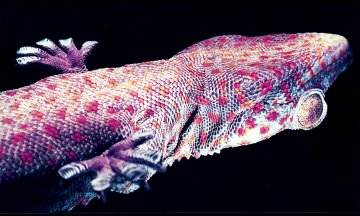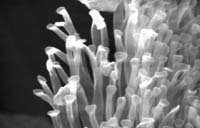How a Gecko Defies Gravity
A gecko's tight grip on walls and ceilings suggests new types of sticky materials.
By Emily Sohn
The spider “almost fell right on me,” says Autumn, who was lying in bed at the time. “I was terrified.”
Once he got over his fear, Autumn started to think about what he had seen. How did both creatures manage to defy gravity and walk on ceilings? And why was the gecko so much stickier than the spider?
 |
|
A gecko has feet that can grip glass, even when the gecko is upside down.
|
| K. Autumn |
Autumn happened to be a gecko expert, based at Lewis & Clark College in Portland, Ore. So, when he came home from Hawaii, he turned his attention to the gravity-defying feats of the little lizard-like creatures.
Six years later, Autumn and his coworkers think they’ve cracked the secret of how geckos stick to surfaces, no matter how smooth. Their work contributes to a growing list of discoveries about spiders, frogs, flies, and other sticky wall-crawlers.
Together, the research could inspire a new generation of super-sticky materials, with applications from medicine to engineering. Some day, you might even use “gecko tape” to walk up walls.
A sticky mystery
People have been fascinated by geckos for thousands of years. In ancient Greece, the philosopher Aristotle wondered how the reptiles could walk upside down. No one had a good answer for him.
Even when scientists got into the act in the last 150 years, they still had trouble cracking the gecko’s secret. Step by step, however, they did manage to narrow down the possibilities.
Originally, some scientists thought that geckos might make a kind of glue to coat their feet. Many insects produce a gooey ooze that allows them to stick to waxy leaves. But geckos don’t leave sticky tracks, so this theory couldn’t be right.
In 1939, a German scientist showed that geckos can stick to glass even when all the air has been sucked out. This finding disproved the idea that the animals might have suction cups on their feet.
Likewise, water doesn’t affect a gecko’s stickiness, which nixes the suggestion that a type of static electricity enhances its grip. Static electricity, which works best under dry conditions, is the kind of force that allows a rubbed balloon to stick to a wall.
The first significant clue came just a few years ago. Geckos have millions of microscopic hairs, or setae, on the bottom of their feet. Autumn’s group used a special microscope to take a closer look at a single hair. “Each hair had a really bad case of split ends,” Autumn says. In fact, a single hair could have hundreds of bristles.
 |
|
A single hair, or seta, on a gecko’s foot splits into hundreds of tiny bristles, or spatulae.
|
| K. Autumn, E. Florance |
The researchers suspected that these hairs might be the key. They used special sensors and microtweezers to analyze the setae, one at a time. Their work revealed a few surprises.
First of all, the hairs aren’t sticky by themselves. “We tried for months,” Autumn says. But “we couldn’t get them to stick until we measured how the gecko really moves its feet and toes. The secret is mechanical.”
Simply pushing the setae onto the surface and dragging them forward a tiny bit makes them stick, the researchers found. Just increasing the angle at which a hair touches a surface then allows the hair to pop off. In effect, a gecko peels off its feet just as you would peel off adhesive tape.
It’s really the size and shape of the tips of gecko foot hairs that matter most. At the right angle and pressure, a single hair can lift the weight of a large ant. A whole gecko’s worth of setae could lift the weight of a child.
Ceiling walkers
Autumn has focused on geckos partly because they are the biggest type of animal that can walk on ceilings. Some of the 850 species of geckos can grow to be as big as iguanas.
Other scientists are taking a broader approach. Around the world, teams of biologists, chemists, physicists, and engineers are using different strategies to understand how a variety of animals might stick to slippery things.
One group in Germany, for example, recently looked at setae in many different creatures that varied in size, from beetles and flies to geckos and spiders. The heavier the animal is, they found, the smaller are its hairs. A beetle’s hairs, for instance, are about a tenth the width of a human hair. A gecko’s hairs are one-fiftieth the size.
“Spider-Man would need hairs that are another factor of 10 to 20 smaller than the gecko’s,” says Ralph Spolenak, a materials scientist from the Max Planck Institute for Metals Research in Germany, who participated in the research. “This is much smaller than anything found in nature so far. So, it’s very unlikely that you will happen to run into Spider-Man down the hallway.”
However, scientists could develop materials that copy what gecko hairs do.
That’s exactly what Autumn and his colleagues have done. To test their theory about gecko adhesion, the researchers designed several types of “gecko tape.” So far, the resulting tape has been sticky, but not nearly as sticky as geckos are on their own.
Researchers continue to work towards making better versions of gecko-inspired tape, with plenty of exciting applications in mind. Think: ouch-less Band-Aids, robots that can climb walls, delicate surgery on one blood vessel at a time, and more.
Eventually, after a lot more work by scientists and engineers, you might even be able put on a pair of gecko gloves and gecko socks and hang out on the ceiling for a while.
“I imagine every one of you has at least once dreamt of being Spider-Man, looking at things from a different perspective, not being subject to everyone else’s constraints,” Spolenak says. “Just being Spider-Man for a while would definitely be very cool.”
“Forget Spider-Man,” Autumn says. “Think Gecko-Girl instead.”
His 7-year-old daughter, Kendra, has already asked to be first in line. Who wants to be number two?
Going Deeper:
News Detective: Emily goes rock climbing







